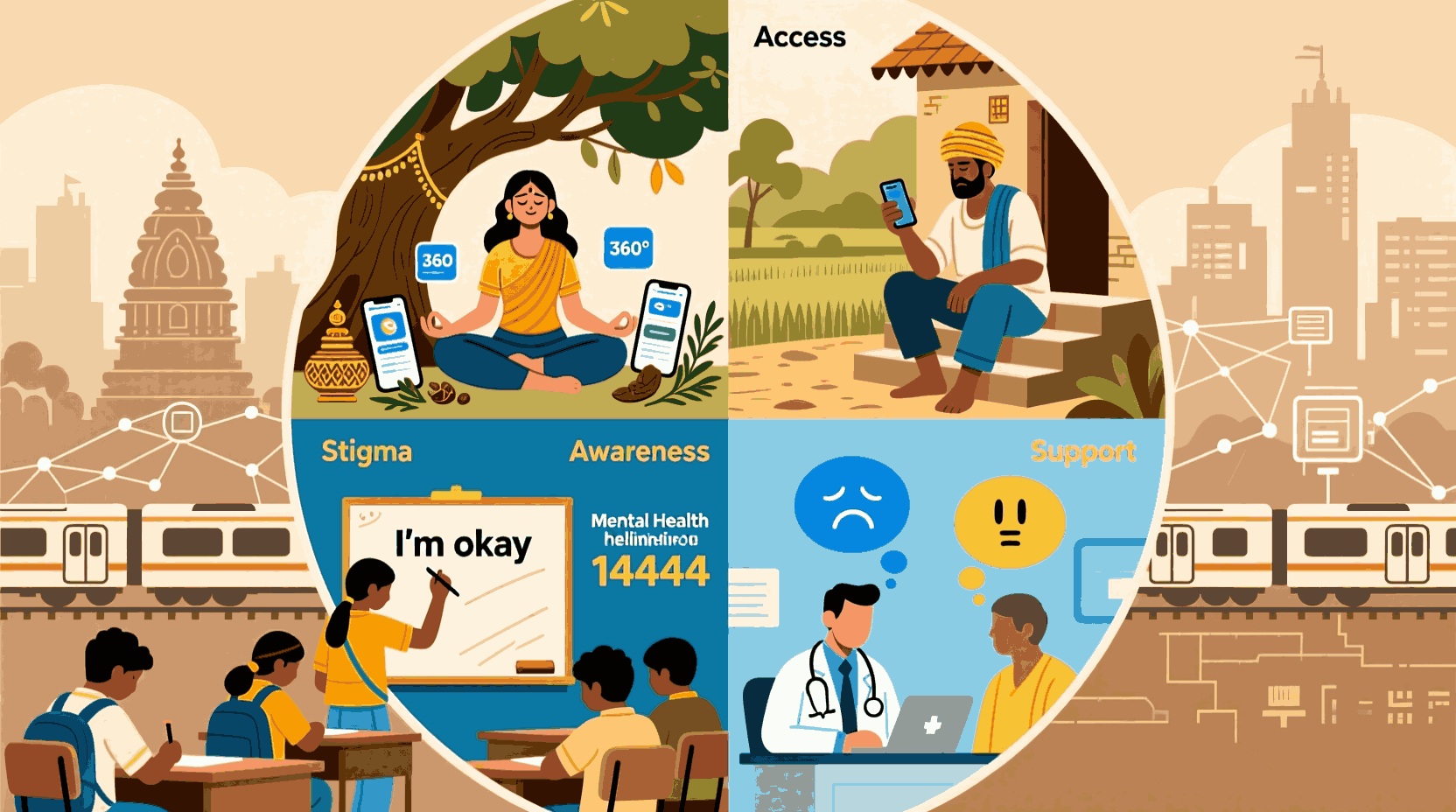1. What is Mental Health & Why It Matters
- Mental health involves emotional, psychological and social well-being.
- It affects how people think, feel, act, and how they cope with stress.
- Good mental health is more than absence of illness — preventive, treatment, support are essential.
Why it matters in India:
- Huge population, diversity, socio-economic inequalities.
- Rapid social change, urbanization, job/income insecurity, educational pressure.
- Stigma, cultural beliefs still strong barriers.
2. Current Statistics & Prevalence in India
| Metric | Figure / Finding | Source |
|---|---|---|
| Adults with “active mental disorders” | ~ 10.6% (India adults over 18) | Govt expansion announcement citing NMHS 2016. DD News |
| Prevalence of depression / major depression | ~1 in 20 adults suffer depression; ~15% need interventions for one or more mental health issues. World Health Organization+1 | |
| Suicide rate (age-adjusted) | ~ 21.1 per 100,000 | WHO: India mental health topic page. World Health Organization |
| Disability burden (DALYs per 100,000) due to mental health conditions | ~ 2443 DALYs / 100,000 | WHO data. World Health Organization |
| Young adult mental health (Jaipur study) | Depression ~ 48.6%, Anxiety ~ 58.1%, Stress ~ 25.4% in young adults (18-25) in Jaipur | Gupta V, Verma S, Tiwari M, Shekhawat DS. “A Study … Young Adults in Jaipur” (2025). IMSEAR |
Trend observations:
- Mental health burden is sizable and growing.
- Young people, urban populations show high prevalence of anxiety and depression.
- Many cases go untreated.
3. Major Risk Factors & Causes Specific to India
- Socio-economic stress: Poverty, unemployment, income instability.
- Educational / exam pressure: Intense competition, parental expectations.
- Urbanisation & migration: Isolation, breakdown of traditional support systems.
- Gender disparities: Women often more prone to depression/anxiety; cultural constraints.
- Stigma & social attitudes: Mental illness often hidden, shameful.
- Climate & environment: Studies suggest heat, humidity correlate with worse mental health in some settings. arXiv
- Childhood trauma / adverse experiences: Strong predictors for risk of mental illness and suicidal behavior. arXiv
4. Impact: Social, Economic & Individual Costs
| Level | Costs & Effects |
|---|---|
| Individual | Reduced quality of life; physical health comorbidities; social isolation; risk of suicide. |
| Family / Community | Care-giver burden; loss of productivity; social stigma affects relationships. |
| Education / Students | Poor academic performance; drop-outs; stress and anxiety; suicide risk. |
| Economy | Lost workdays; healthcare expenses; lowered GDP growth potential; under-utilised talent. |
WHO estimates the economic loss due to mental health conditions in India between 2012-2030 is ~ USD 1.03 trillion. World Health Organization
5. Legal Framework & Rights
- Mental Healthcare Act, 2017: Key law. It replaced older Act (1987). Decriminalised suicide; ensures rights of persons with mental illness; mandates accessible, affordable quality care. Wikipedia+1
- Rights under MHCA 2017 include:
• Right to access mental health care.
• Non-discrimination.
• Right to information, confidentiality, community living. Vikaspedia+1 - Government commitments to train medical officers in all public health establishments to provide basic mental health care. India Code+1
6. Government Initiatives & Programs
Here are some of the major government efforts:
| Initiative | Key Features / Scale | Impact or Status |
|---|---|---|
| National Mental Health Programme (NMHP) & District Mental Health Programme (DMHP) | Community outreach; integration with general healthcare; outpatient, psycho-social interventions; in 767 districts DMHP expanded. DD News+1 | Increased access especially in rural / semi-urban areas; better awareness. |
| Tele-MANAS / National Tele Mental Health Programme (NTMHP) | Launched Oct 2022; 24×7 tele-counseling helpline (14416), multi-language; Tele-MANAS Cells across 36 states/UTs; app/mobile access. DD News+2NASSCOM Community+2 | Helps reduce access barriers; large call volumes; reaching areas without specialists. |
| Ayushman Bharat / Health & Wellness Centres (HWCs) / Arogya Mandirs | Over 1.73 lakh PHCs/SHCs upgraded; mental health services added to primary care package. Mookerjee Foundation+1 | Early detection; accessing care close to home. |
| Centers of Excellence & PG Department Strengthening | 25 Centres of Excellence; 47 PG departments in mental health specialties at 19 government medical colleges. DD News+1 | Increased workforce, more specialists; improved tertiary care. |
| State / Local Initiatives | E.g., Maharashtra’s Udaan scheme (rural mental health screening & outreach). The Times of India; Himachal Pradesh de-addiction centres; CBSE-AIIMS mental health series in schools. The Times of India+1 | Varying levels of impact depending on implementation; good models for scaling. |
7. Health Infrastructure, Human Resources & Gaps
| Area | Status | Gap / Challenge |
|---|---|---|
| Number of mental health professionals (psychiatrists, psychologists, therapists) | Very low per capita. The Economic Times+1 | Shortage especially in rural areas; uneven distribution across states. |
| Mental health facilities & beds | Some expansion (e.g. Bihar’s Bimhas adding beds). The Times of India | Many districts still lack even basic inpatient facilities; under-resourced hospitals. |
| Accessibility in rural / remote / underserved areas | Efforts via DMHP, Tele-MANAS, Wellness Centres. | Physical access, transportation, awareness remain barriers. |
| Budget and funding allocation | Some increased funding; inclusion under PM-Ayushman Bharat, etc. | Mental health still a small portion of overall health budget; many areas under-funded. |
| Awareness & stigma | Increasing awareness campaigns, school-based programs. | Deep cultural stigma; mental illness often misunderstood; help-seeking low. |
8. Comparisons: India vs Global Benchmarks
| Metric | India | Global Avg / Recommended Benchmark |
|---|---|---|
| Psychiatrists per 100,000 | ~ 0.75 psychiatrists per 100,000 in India. The Economic Times | WHO recommendation closer to 1.5–2 or more per 100,000 depending on population burden. |
| Suicide rate (age-adjusted) | ~21.1 / 100,000 population. World Health Organization | Global average is about 9-11/100,000 (varies by region). India is above average. |
| % of GDP / Health budget on mental health | Low percentage (~2-3% or less in many reports) | Many high income countries allocate higher shares; WHO suggests higher investment. |
| Treatment gap | High; many people with mental disorders do not get treatment. | In many LMICs, < 20-30% access; WHO aims for Universal Health Coverage. |
9. Innovation, Technology & Community Efforts
- Digital Helplines & Tele-counseling: Tele-MANAS, KIRAN helpline. NASSCOM Community+1
- Mental Health Apps & AI Tools: Some emerging work on chatbots for adolescents, culturally-adapted digital tools. arXiv
- Research & Predictive Analytics: Studies using machine learning to flag suicidal behavior, early risk detection. arXiv
- Community / Peer Support: NGOs, local health workers (ASHA etc.) doing screenings, outreach (e.g. Udaan program). The Times of India
10. Key Challenges
- Stigma & Cultural Barriers: Deep rooted beliefs, lack of mental health literacy.
- Workforce Shortage: Psychiatrists, psychologists, counsellors in insufficient numbers.
- Uneven Distribution: Urban vs rural, richer states vs poorer states disparity.
- Funding Constraints: Low budget allocation; dependence on state budgets; out-of-pocket costs.
- Service Quality & Continuity: Even when services exist, maintaining quality and long-term follow-ups hard.
- Data & Monitoring: National surveys old (NMHS 2015-16), less frequent updates; under-reporting.
- Access Barriers: Geographic, socio-linguistic, linguistic, financial.
11. Strategies Moving Forward
Here are strategies that can help strengthen mental health outcomes in India:
- Update Data & Surveys
- Conduct new national mental health surveys more often.
- Disaggregate by region, age, gender, urban/rural.
- Scale Up Primary Care Integration
- Continue strengthening HWCs / PHCs with mental health screening & basic treatment.
- Train general medical officers, ASHA workers in mental health first aid.
- Expand Digital & Tele Services
- Increase reach of Tele-MANAS; ensure connectivity in remote areas.
- Use culturally relevant apps, chatbots, localized content.
- Boost Workforce Capacity
- More training seats; incentivize mental health professionals to work in underserved areas.
- Increase postgraduate, clinical psychology, counselling courses.
- Increase Budget & Funding
- Allocate a higher share of health budget to mental health.
- Public-private partnerships; NGO collaboration.
- Reducing Stigma & Awareness
- School programmes (wellness education), media campaigns.
- Community engagement to change perceptions.
- Strengthen Legal Safeguards & Rights Implementation
- Proper functioning of Mental Health Review Boards.
- Enforce rights under MHCA 2017.
- Targeted Support for Vulnerable Groups
- Youth, adolescents; women in distress; marginalized communities.
- Suicide prevention in students, workplace mental health.
12. FAQ
Q. What is the Mental Healthcare Act, 2017?
A law passed by Indian Parliament that ensures rights of persons with mental illness; decriminalized suicide; mandates accessible, affordable mental healthcare. Wikipedia+1
Q. How many people in India suffer from mental health issues?
According to the National Mental Health Survey (2015-16), about 10.6% of adults over 18 need active intervention for one or more mental disorders. DD News+1
Q. What is Tele-MANAS?
A national tele mental health programme started in October 2022. Provides 24×7 tele-counseling through helpline 14416 in many languages, via call centers, app/mobile interfaces. DD News+1
Q. Are suicide attempts still criminalised in India?
No. Under MHCA 2017, attempted suicide is presumed to be the result of severe stress; not punishable under Section 309 of IPC or its replacement. Wikipedia+1
Q. How many specialists are available vs what is needed?
India has ~0.75 psychiatrists per 100,000 people, which is well below recommended ratios. Also shortages of psychologists, counsellors. The Economic Times
Q. Which states or programmes are doing well?
- Maharashtra’s Udaan scheme: large rural screening & outreach. The Times of India
- Himachal Pradesh has sanctioned de-addiction and rehab centres. The Times of India
- CBSE / AIIMS school-based mental health awareness series. The Times of India
Conclusion
Mental health in India is a critical public health issue. Government laws, programmes and technological innovations are making positive strides. Yet, large gaps in access, workforce, funding and stigma still exist. With focused investment, updated data, stronger implementation of rights, and community involvement, India has potential to significantly improve mental health outcomes. The key will be ensuring that policies don’t stay on paper, but reach people — especially in remote, underserved populations.



